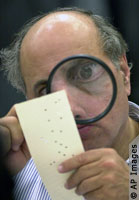Hanging chad: Difference between revisions
imported>George Swan m (trim) |
mNo edit summary |
||
| (6 intermediate revisions by 2 users not shown) | |||
| Line 1: | Line 1: | ||
{{subpages}} | {{subpages}} | ||
'''Hanging chad''', alternately '''dimpled chad''' or '''pregnant chad''', is a term that was widely used following the 2000 [[United States]] [[United States President|Presidential]] election.<ref name=Risks21-12-1-1> | {{Image|Looking for hanging chad, 2000 Presidential election.jpg|right|139px|An election worker closely examines a [[Florida (U.S. state)|Florida]] [[punch card]] [[ballot]] from the [[2000 US Presidential election]] for signs of a hanging chad.}} | ||
'''Hanging chad''', alternately '''dimpled chad''' or '''pregnant chad''', is a term that was widely used following the 2000 [[United States of America]] [[United States President|Presidential]] election.<ref name=Risks21-12-1-1> | |||
{{cite news | {{cite news | ||
| url=http://catless.ncl.ac.uk/Risks/21.12.html#subj1.1 | | url=http://catless.ncl.ac.uk/Risks/21.12.html#subj1.1 | ||
| Line 33: | Line 34: | ||
==Controversy== | ==Controversy== | ||
In the United States electoral system the design of | In the United States electoral system the design of [[ballot]]s, and their collation, is not the responsibility of a Federal agency. Each state appoints its own chief [[returning officer]]. Each county designs its own ballots. | ||
The results in Florida were very close. | The results in Florida were very close. | ||
| Line 40: | Line 41: | ||
Bipartisan committees were going to examine every punch card ballot. | Bipartisan committees were going to examine every punch card ballot. | ||
The term "[[chad]]" is used for the piece of paper left when a hole is punched out of a card or piece of paper. The punch card ballots were to be examined for the presences of partially punch out chads. | The term "[[chad (paper byproduct)|chad]]" is used for the piece of paper left when a hole is punched out of a card or piece of paper. The punch card ballots were to be examined for the presences of partially punch out chads. | ||
==Reverse engineering the problem== | ==Reverse engineering the problem== | ||
| Line 62: | Line 63: | ||
==References== | ==References== | ||
<references/> | <references/>[[Category:Suggestion Bot Tag]] | ||
Latest revision as of 11:01, 25 August 2024

An election worker closely examines a Florida punch card ballot from the 2000 US Presidential election for signs of a hanging chad.
Hanging chad, alternately dimpled chad or pregnant chad, is a term that was widely used following the 2000 United States of America Presidential election.[1][2][3]
Controversy
In the United States electoral system the design of ballots, and their collation, is not the responsibility of a Federal agency. Each state appoints its own chief returning officer. Each county designs its own ballots.
The results in Florida were very close. Several counties used voting machines that used punch cards. The punch card system did not provide an independently verifiable audit trail. Bipartisan committees were going to examine every punch card ballot.
The term "chad" is used for the piece of paper left when a hole is punched out of a card or piece of paper. The punch card ballots were to be examined for the presences of partially punch out chads.
Reverse engineering the problem
Douglas W. Jones, a professor of Computer Science at the University of Iowa, and the curator of a museum on the history of the punch card, reported having one of the controversial votomatic machines delivered to him, and reverse-engineering the problem with the punch card ballots in the 2000 elections.[2][3]
Jones reported that the problem was due to improperly designed ballots that placed candidate Al Gore's name above hidden support bars, that did not allow enough clearance for chads punched out by voters who selected him.[2][3] Proper design of ballots using these machines will never place a candidate's name above one of these support bars.
The "hanging chad" problem, with the same votomatic machines, had marred the results of the 1988 Florida Senate race between Buddy Mackay and Connie Mack.[4]
References
- ↑ Lauren Weinstein. Sanity in the Election Process, Risks digest, 2000-11-11. Retrieved on 2008-06-26.
- ↑ 2.0 2.1 2.2 Douglas W. Jones. Pregnant chad revisited, Risks digest, 2001-10-19. Retrieved on 2008-06-26.
- ↑ 3.0 3.1 3.2 Douglas W. Jones. Chad -- From waste product to headline, University of Iowa, 2002. Retrieved on 2008-06-26. mirror
- ↑ Peter G. Neumann. Pregnant chad revisited, Risks digest, 2001-10-22. Retrieved on 2008-06-26.